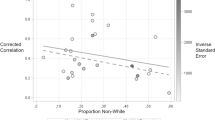Abstract
Although studies have described work processes among employed African American women, few have examined the influence of these processes on job outcomes. This study examined relationships between African American women's exposure to a range of occupational stressors, including two types of racial bias—institutional discrimination and interpersonal prejudice—and their evaluations of job quality. Findings indicated that institutional discrimination and interpersonal prejudice were more important predictors of job quality among these women than were other occupational stressors such as low task variety and decision authority, heavy workloads, and poor supervision. Racial bias in the workplace was most likely to be reported by workers in predominantly white work settings. In addition, Black women who worked in service, semiskilled, and unskilled occupations reported significantly more institutional discrimination, but not more interpersonal prejudice, than did women in professional, managerial, and technical occupations or those in sales and clerical occupations.
Similar content being viewed by others
REFERENCES
Albright, C. L., Winkelby, M. A., Ragland, D. R., & Fisher, J. (1992). Job strain and prevalence of hypertension in a biracial sample of urban bus drivers. American Journal of Public Health, 82, 984–989.
Alderfer, C., Alderfer, C., Tucker, L., & Tucker, S. (1980). Diagnosing race problems in management. Journal of Applied Behavior Science.
Aronnson, G., Dallner, M., & Aborg, C. (1994). Winners and losers from computerization: A study of the psychosocial work conditions and health of Swedish state employees. International Journal of Human-Computer Interaction, 6, 17–35.
Baba, V. V., & Jamal, M. (1991). Routinization of job context and job content as related to employees' quality of working life: A study of Canadian nurses. Journal of Organizational Behavior, 12, 379–386.
Bell, E. L. (1990). The bicultural life experience of career-oriented black women. Journal of Organizational Behavior, 11, 459–477.
Billingsley, A. (1968). Black families in white America. New York: Simon & Schuster.
Bowman, P. J. (1991). Work life. In J. S. Jackson (Ed.), Life in black America (pp. 124–155). Newbury Park, CA: Sage.
Brisson, C., Vexina, M., & Vinet, A. (1992). Health problems of women employed in jobs involving psychological and ergonomic stressors: The case of garment workers in Quebec. Women and Health, 18, 49–65.
Carayon, P. (1992). A longitudinal study of job design and worker strain: Preliminary results. In J. C. Quick, L. R. Murphy, & J. J. Hurrell (Eds.), Stress and well-being at work. Washington, DC: American Psychological Association.
Clegg, C., Wall, T., & Kemp, N. (1987). Women on the assembly line: A comparison of main and interactive explanations of job satisfaction, absence, and mental health. Journal of Occupational Psychology, 60, 273–287.
Cose, E. (1993). The rage of a privileged class. New York: Harper/Collins.
Cox, T., & Nkomo, S. M. (1990). Invisible men and women: A status report on race as a variable in organization behavior research: Special Issue: The career and life experiences of Black professionals, Journal of Organizational Behavior, 11, 419–431.
Davis, G., & Watson, G. (1982). Black life in corporate America. Garden City, NY: Doubleday.
Dovidio, J. F., & Gaertner, S. L. (1986). Prejudice, discrimination and racism. New York: Academic Press.
Essed, P. (1990). Everday racism. Alameda, CA: Hunter House. ia]Families and Work Institute. (1995). National Study of the Changing Workforce: 1992: Public use data file and documentation. Unpublished document.
Feagin, J. R., & Sikes, M. P. (1994). Living with racism: The Black middle class experience. Boston: Beacon Press.
Haynes, S.G., LaCroix, A. Z., & Lippin, T. (1987). The effect of high job demands and low control on the health of employed women. In J. C. Quick, Rabbi Rasbhagat, J. Dalton, & J. D. Quick (Eds.), Work stress: Health care systems in the workplace (pp. 93–110). New York: Praeger.
Hill, R. B. (1971). The strengths of Black families. New York: Emerson Hall.
House, J. S., & Smith, D. A. (1985). Evaluating the health effects of demanding work on and off the job. Paper presented for the National Center for Health Statistics (NCHS) workshop on assessing physical fitness and activity patterns in NCHS General Population Surveys, Arlie, VA.
Hughes, D., & Dumont, K. (1993). Focus groups as culturally anchored methodology. American Journal of Community Psychology, 21, 775–806.
James, K., Lovato, E., & Khoo, G. (1994). Social identity correlates of minority workers' health. Academy of Management Journal, 37, 383–396.
Karasek, R. A. (1985). Job Content Instrument: Questionnaire and user's guide. Los Angeles, CA: Department of Industrial and Systems Engineering.
Karasek, R. A., Baker, R., Marxer, F., Ahlbom, A., & Theorell, T. (1981). Job decision latitude, job demands, and cardiovascular disease: A retrospective study of Swedish men. American Journal of Public Health, 71, 694–705.
Karasek, R., Gardell, B., & Lindell, J. (1987). Work and non-work correlates of illness and behaviour in male and female Swedish white collar workers. Journal of Occupational Behaviour, 8, 187–207.
Karasek, R. A., Theorell, T., Schwartz, J., & Alfredson, L. (1982). Job psychological factors and coronary heart disease. Advanced Cardiology, 29, 62–67.
Landsbergis, P. A. (1988). Occupational stress among health care workers: A test of the job demands-control model. Journal of Organizational Behavior, 9, 217–239.
Lykes, M. B. (1983). Discrimination and coping in the lives of Black women. Journal of Social Issues, 39, 79–100.
Marshall, N. L., & Barnett, R. C. (1991). Race, class, and multiple role strains and gains among women employed in the service sector, Women and Health, 17, 1–19.
Martin, S. E. (1994). “Outsider within” the station house: The impact of race and gender on black women police. Social Problems, 41, 383–400.
McGuire, G. M., & Reskin, B. F. (1993). Authority hierarchies at work: The impacts of race and sex, Gender and Society, 7, 487–506.
Mercer, S., Heacock, P., & Beck, C. (1993). Nurses aides in nursing homes: Perception of training, workloads, racism, and abuse issues. Journal of Gerontological Social Work, 21, 95–112.
Moch, M. K. (1980). Racial differences in job satisfaction: Testing four common explanations. Journal of Applied Psychology, 65, 299–306.
Mortimer, J. T., & Sorenson, G. (1984). Men, women, work, and family. In K. M. Borman, D. Quarm, & S. Gideonse (Eds.), Women in the workplace: Effects on families (pp. 139–168). Norwood, NJ: Ablex.
Orpen, C. (1992). Social support as a moderator of the effect of work stress on personal strain among Black employees in South Africa. Journal of Social Psychology, 132, 269–270.
Pettigrew, T. F., & Martin, J. (1987). Shaping the organizational context for Black American inclusion. Journal of Social Issues, 43, 41–78.
Quinn, R. P., & Staines, G. (1977). The 1977 Quality of Employment Survey. Ann Arbor: Survey Research Center, Institute for Social Research, The University of Michigan.
Richardson, E. L. (1973). Work in America. Report to a Special Task force to the secretary of Health, Education, and Welfare. Cambridge, MA: MIT Press.
Richie, B. (1992). Coping with work: Interventions with African American women. Special issue: Finding voice: Writing by new authors. Women and Therapy, 12, 97–111.
Rodriguez, A. M. (1987). Institutional racism in the organizational setting: An action research approach. In J. W. Shaw (Ed.), Strategies for improving race relations: The Anglo-American experience (pp. 128–148). Manchester, U.K.: Manchester University Press.
Seltzer, R., & Thompson, E. (1985). Attitudes towards discrimination and affirmative action for minorities and women (Research Reports, 143). Washington, DC: Howard University, Institute for Urban Affairs and Research.
Steele, S. (1993). The content of our character. New York: St. Martins.
Sutherland, M. E., & Harell, J. P. (1986). Individual differences in physiological response to fearful, racially noxious, and neutral imagery. Imagination, Cognition, and Personality, 6, 133–150.
Thomas, D. A., & Alderfer, C. P. (1989). The influence of race and career dynamics: Theory and research on minority career experiences. In M. B. Arthur, D. T. Hall, & B. S. Lawrence (Eds.), Handbook of career theory. Cambridge, U.K.: Cambridge University Press.
Tuch, S. A., & Martin, J. K. (1991). Race in the workplace: Black/white differences in the sources of job satisfaction. Sociological Quarterly, 32, 103–116. ia]U.S. Department of Commerce. (1994). Statistical abstract of the United States 1994. ia]U.S. Bureau of the Census. (1989). Statistical abstract of the United States, (Table 640, p. 386). ia]U.S. Bureau of Labor Statistics (1994, January). Employment and earnings. ia]U.S. Department of Labor, Women's Bureau (1996, November). Factos on working women: Black women in the labor force (No. 96-4).
Vetter, B. M. (1981). Women scientists and engineers: Trends in participation. Science, 214, 1313–1321.
Wilson, W. J. (1973). Power, racism, and privilege: Race relations in theoretical and sociohistorical perspectives. New York: Free Press.
Author information
Authors and Affiliations
Rights and permissions
About this article
Cite this article
Hughes, D., Dodge, M.A. African American Women in the Workplace: Relationships Between Job Conditions, Racial Bias at Work, and Perceived Job Quality. Am J Community Psychol 25, 581–599 (1997). https://doi.org/10.1023/A:1024630816168
Issue Date:
DOI: https://doi.org/10.1023/A:1024630816168




